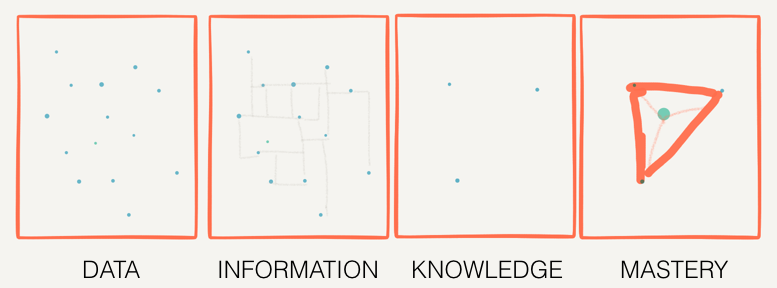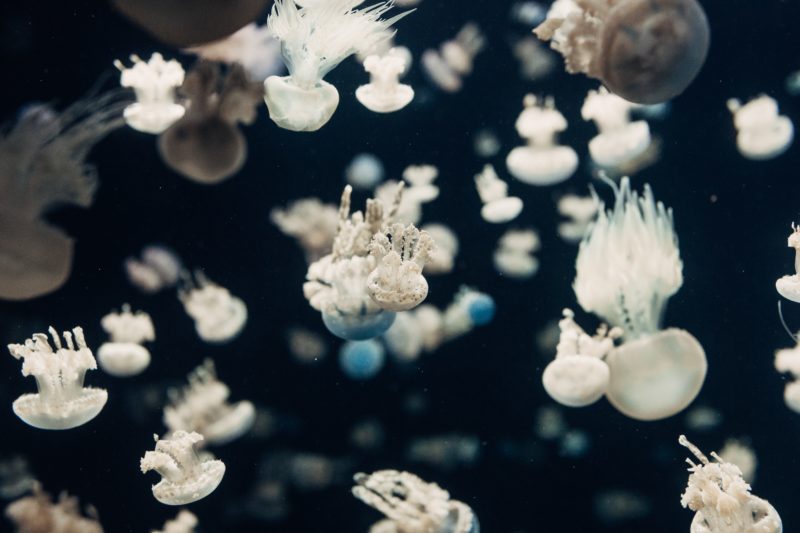Homo contactus has arrived!
New era, new thinking.
Harold Jarche opened a new box for me.
A recent post on his blog ignited a series of thoughts in my mind.
Thinking back on Rodin’s “The thinker” as the old way of thinking : solitary and deep.
Are we so far down the rabbit hole in this new era of social networks that we cannot think deeply anymore?
Is “real” thinking solely the realm of solitary reflection?
Harold does not think so. And I do not either.
I recently used a brain analogy to explain this.
The brain is composed of a hundred billion neurons and even more glial cells, facilitating the connections between neurons. Connections between the neural cells is mostly random, each neuron connecting with as much as ten thousand (10 000) other cells. No neuron contains the whole information. The neural network holds the space for knowledge.
New knowledge is then retained when the signal for it is repeated frequently.
Experiments with fruit flies (Proc Natl Acad Sci U S A. 1974 Mar; 71(3): 708–712.Conditioned Behavior in Drosophila melanogaster,William G. Quinn, William A. Harris, and Seymour Benzer) demonstrated decades ago that even a minuscule fruit fly can learn upon repeated stimulus.
But true memory is only acquired when a second parameter is introduced : rest (Tully T, Preat T, Boynton SC, Del Vecchio M. Genetic dissection of consolidated memory in Drosophila. Cell. 1994;79:35–47). Rest was necessary for protein synthesis to occur. Long term memory was sensitive to cycloheximide, a known protein synthesis inhibitor, whereas short term memory was not.
Ok, ok… enough of my former life as a molecular biologist.
I am now an organizational biologist. So back to Harold’s article. But keep the last paragraph in mind.
How does knowledge occur?
Thinking alone certainly works. Thinking deeply for a long time strengthens the stimulus, induces profound breathing more associated with the resting stage than the typical training environment of a classroom at work… more stressful and not as conductive to learning as one corporate trainer might think.
Thinking alone is a slow and repetitive process. One thinks, tests one’s hypothesis, thinks some more and so forth. All the hallmarks of a neural connection occurring after a stimulus. Not being a fruit fly, one’s has an abundance of neurons to use for such a process.
A slow process.
Evolution and history prove that it works.
But here come computers, social networks and communication satellites.
Homo contactus has arrived!
By looking at the incredible progression of social networks one realizes that evolution has taken a radical turn for man.
First few years of social media progression
2001
May 1
Wikipedia, a free encyclopedia that anyone can edit, launches.
November
StumbleUpon, a website that recommends web content to its users, begins.2002
2002
March 22
Friendster, considered the granddaddy of social networks, launches.
November
Technorati, a search engine for blogs, goes live.
2003
May
LinkedIn begins. LinkedIn strives to be known as a business-related social networking site used by professionals from its inception.
May 23
WordPress, a publishing platform that hosts blogs, is released.
2004
January
Myspace is launched.
January 4
Google begins Gmail.
February
Flickr, an image and video hosting website, goes live.
March 1
Facebook, a social networking service which began at Harvard, expands to other universities.
October
Yelp, a social networking site where users can review local businesses, begins.
December 5
DIGG, a social news website, goes live.
December 30
Facebook reaches one million members.
Knowledge now doubles every 12 months or so. Oh… not knowledge but information. Subtle difference. And here lies the crux of the matter.
As Niels Pflaeging mentions one needs to filter information from data and then assemble this into knowledge. Only with deep and slow thinking can one hope to make sense of it all.
Wellllll, not anymore.
There is now so much information that one alone cannot succeed. We need the thinking structure of a brain to do this. A brain of brains. A network of networks… which is exactly how the web is connected.
Ray Kurzweil described the coming Artificial Intelligence not as a Terminator/Skynet power/Knowledge grid or a Matrix type super sentient computer but rather by connecting billions of minicomputers… our mobile devices and the global web.
We therefore already have a semi-sentient highly reactive AI: our numerous networks, all interconnected and responsive.
A single comment or “like” on Facebook might eventually have the same effect as the famous Lorenz’s butterfly.
Learning and thinking can now be social.
And fast!
And deep!
As long as the proper process is understood and put in place.
Harold did just that with his PKM workshop. I now think of PKM as the most essential tool of the knowledge worker in this digital age.
Seek.
Sense.
Share.
And I would humbly add… repeat!
Seek, randomly at first, like a neuron connecting to another neuron in the brain.
Seek throughout the numerous sources of information.
Seek colleagues and peers with similar interests or vastly different passions and be prepared to be surprised!
Sense, makes sense of this information. It used to be enough to read the morning paper. What if you could read the morning papers of a thousand cities? Or rather, trust your networked colleagues to extract the relevant information and relay it to you…
Sense, filter and re-extract information in order to transform it, through repeated exposures and multiple interpretations into knowledge.
And finally share with your network. To help. To cooperate to the global thinking process. To reflect some more and to alter your original idea.
To think.
Fast.
And deep.
Together as one.
Repeatedly.
Again.
Much like a neuron seeking other neurons to connect and share neurotransmitters and solidify the connection over time.
Randomness.
Connection.
Time.
Repetition.
The global brain at work through the internet.
One’s brain is not the sole owner of knowledge. No organization can survive on its own. We are all part of the “symbiote” as Joel De Rosnay now call our ecosystem.
All connected.
And interdependent.
Together as one.
The homo contactus has arrived!
© Copyrighted material Aliter Concept™ 2016. Please do not print or copy without permission from the author.
BUT DO SHARE IT using the social network buttons !!
ARTICLES RÉCENTS
26 octobre 2020
We must act and adapt
The change management initiatives of the past have been a resounding failure. 60–70% of them fail.……
11 décembre 2019
Law of attraction…again!
Law of attraction...again! A simple mind trick to make it happen. Your brain hold the key. But,…
26 septembre 2019
Best techno tools for time management
Best techno tools for time management. Oh this might shock you!
5 mars 2019
Rapid culture change oxymoron alert!
Rapid culture change oxymoron alert! This is a true story. I was having a serious discussion with a…




